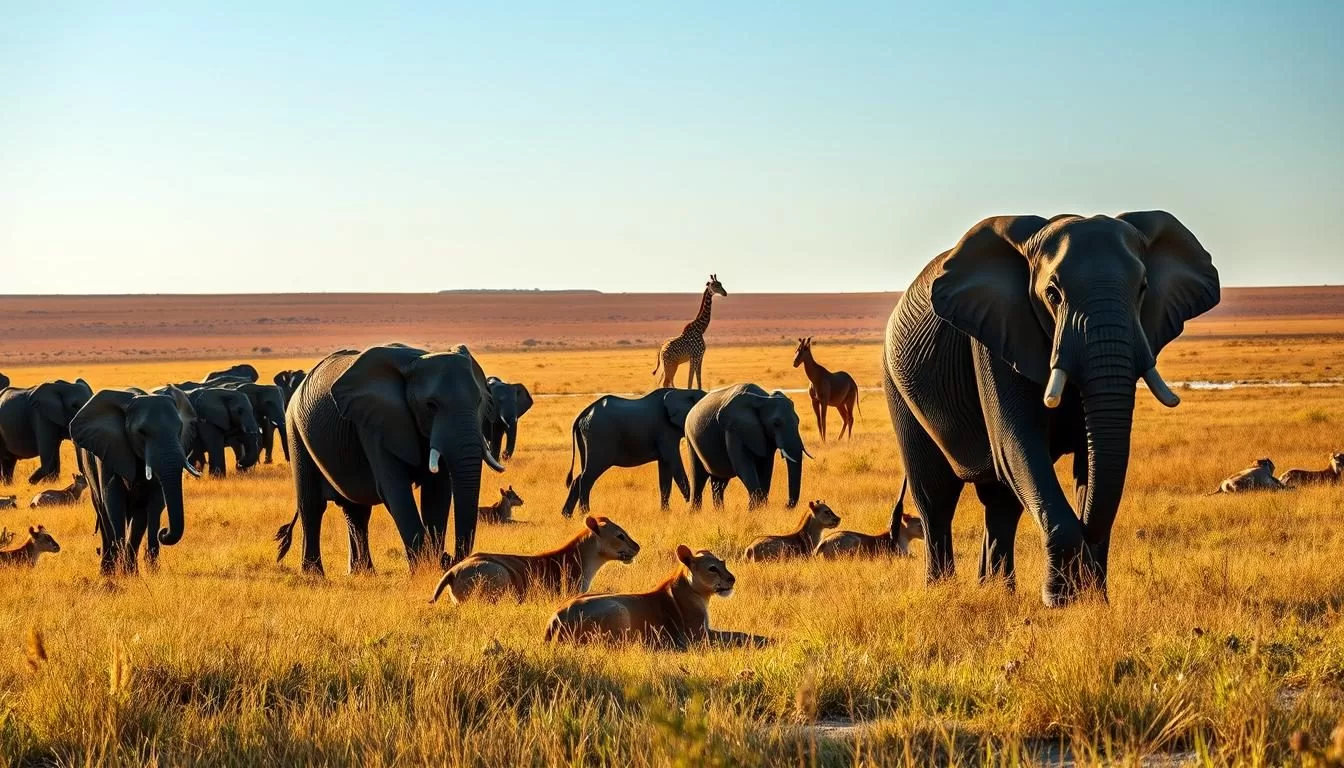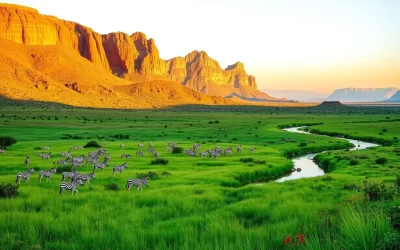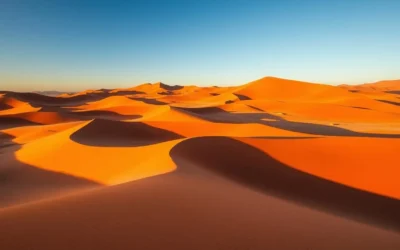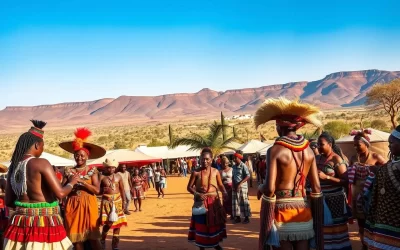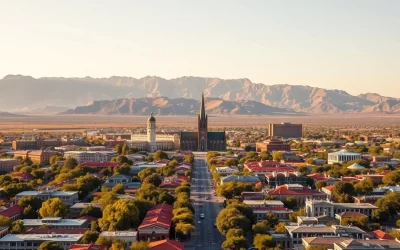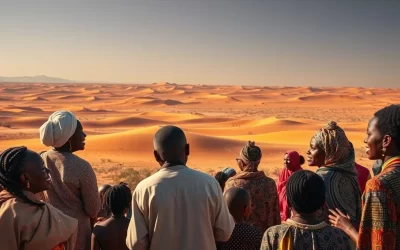✓ Accommodations ✓ Flights ✓ Rental Cars ✓ Tours & Activities
Planning a safari trip to Namibia requires understanding the country’s unique climate patterns to ensure the best wildlife viewing experience.
Namibia’s diverse landscapes, from the Namib Desert to Etosha National Park, offer breathtaking scenery and diverse wildlife. The country’s dry and wet seasons significantly impact the best time to visit for optimal wildlife viewing and photography opportunities.
While you can visit Namibia year-round, certain months offer better safari experiences with concentrated wildlife around waterholes. Understanding these seasonal variations is crucial for planning a weather-savvy trip to this stunning African destination.
Understanding Namibia’s Climate Patterns
Understanding Namibia’s climate is crucial for planning your trip, as it varies significantly across the country. Namibia’s climate is generally very dry and pleasant, with significant variations between the dry and wet seasons.
The Dry and Wet Seasons Explained
Namibia experiences two primary seasons: a dry winter season from May to October and a wet summer season from November to April. The dry season features clear skies, minimal rainfall, and moderate daytime temperatures, making it the optimal time to visit for most travelers. In contrast, the wet season brings rising temperatures and occasional afternoon thunderstorms, particularly in the central and eastern regions.
- The dry season is ideal for wildlife viewing due to the concentration of animals around water sources.
- The wet season transforms the landscape, making it lush and green, and is excellent for birdwatching.
Regional Climate Variations Across Namibia
Regional climate differences are significant in Namibia. The Namib Desert, one of the world’s driest deserts, receives minimal precipitation year-round, while the northeastern regions experience more rainfall. The coastal areas tend to be cooler than the inland regions, and temperature variations between day and night can be extreme, especially in desert areas.
Understanding these variations is key to planning your trip and making the most of your time in Namibia.
May to October: The Prime Time for Namibia Travel
For an unforgettable Namibian adventure, consider visiting between May and October. This period is characterized by dry conditions that make wildlife viewing easier and game drives more rewarding.
Wildlife Viewing Advantages During Dry Season
During the dry season, wildlife gathers around limited water sources, making it easier to spot animals, especially in Etosha National Park. The dry conditions concentrate wildlife around waterholes, creating exceptional wildlife viewing opportunities. You can expect to see a variety of animals, including elephants, lions, and giraffes, as they congregate around these water sources.
| Park/Reserve | Wildlife Viewing | Best Time |
|---|---|---|
| Etosha National Park | Excellent | May to October |
| Namib-Naukluft National Park | Good | June to September |
| Other Reserves | Good | May to October |
Comfortable Temperatures and Clear Skies
The dry season offers comfortable daytime temperatures, ranging from 70-75°F, making it ideal for game drives and outdoor activities. The clear, dust-free skies of May and early June provide excellent photography conditions, with vibrant landscapes and excellent visibility. However, it can get cold at night and in the mornings, especially from June to August, so it’s essential to pack warm clothing.
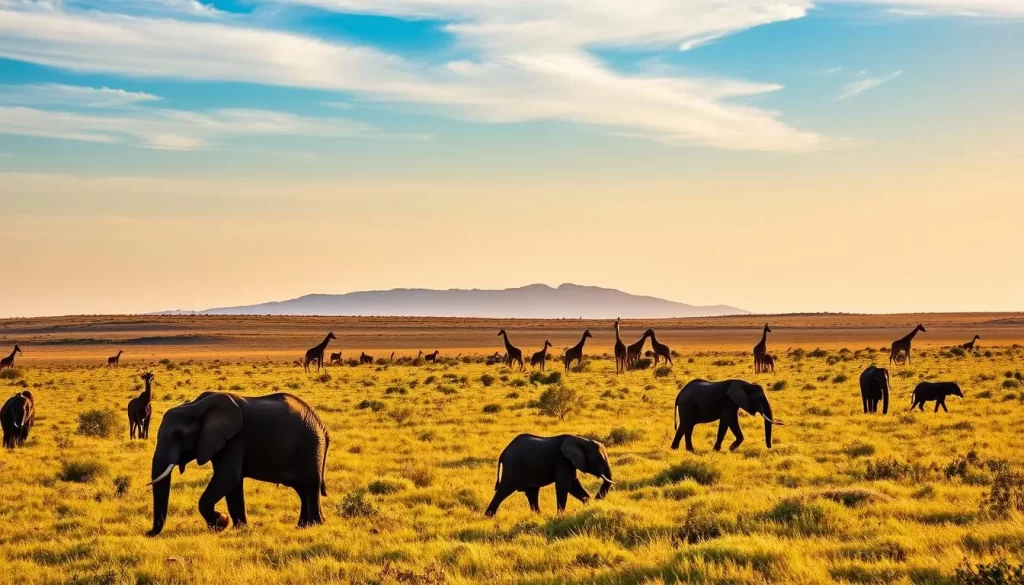
Peak Season Considerations for Travelers
While May to October is the peak tourist season, most parks and reserves don’t feel overcrowded, except for popular spots like Etosha and parts of Namib-Naukluft National Park. The dry conditions mean virtually no rain, allowing for reliable travel plans and consistent road conditions throughout the country. You should be prepared for larger crowds during July and August, but the overall experience remains enjoyable.
July to September: Namibia’s Best Months for a Weather-Savvy Trip
Namibia’s dry season, from July to September, offers the perfect blend of comfortable weather and exciting wildlife viewing opportunities. During this period, the country experiences its peak dry season, making it an ideal time for tourists.
Perfect Wildlife Viewing at Etosha National Park
Etosha National Park is a highlight for any visitor to Namibia during July to September. The dry conditions cause animals to congregate around waterholes, making wildlife viewing exceptionally good. You can expect to see a wide variety of animals, including elephants, lions, and giraffes, as they gather around the limited water sources.
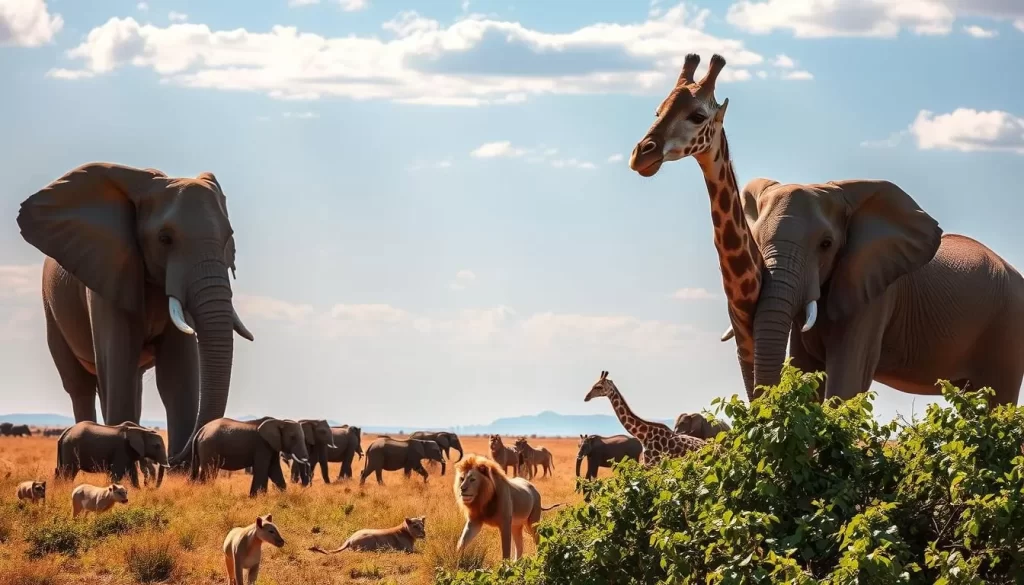
Ideal Photography Conditions in the Namib Desert
The Namib Desert is another must-visit destination during this time. The clear, dust-free skies and dramatic lighting conditions create ideal photography conditions, especially at iconic locations like Sossusvlei and Deadvlei. The stark contrast between the deep blue skies and the orange dunes reaches its visual peak during these months.
Comfortable Day Temperatures and Cool Nights
During July to September, day temperatures in Namibia are comfortably between 70-79°F, while night temperatures cool down significantly. This creates perfect conditions for both daytime exploration and comfortable sleeping. The dry conditions also ensure that roads remain accessible and activities are rarely disrupted by weather, making it the best time for a well-rounded Namibian experience.
November to April: Experiencing Namibia’s Green Season
The period between November and April marks Namibia’s green season, characterized by lush landscapes and newborn wildlife. This time of year offers a unique experience for travelers, with the landscape transforming dramatically after the seasonal rains.
The Dramatic Transformation of the Landscape
During the green season, Namibia’s arid landscape is briefly transformed into a lush environment. The desert areas bloom, and typically dry riverbeds flow with water, creating a vibrant scenery that is quite different from the dry season.
Birding Opportunities and Newborn Wildlife
The rainy season coincides with the birth of many wildlife species, providing a unique opportunity to see newborn animals. Additionally, birdwatching reaches its peak as migratory species arrive, with areas like the Caprivi Strip hosting over 450 species.
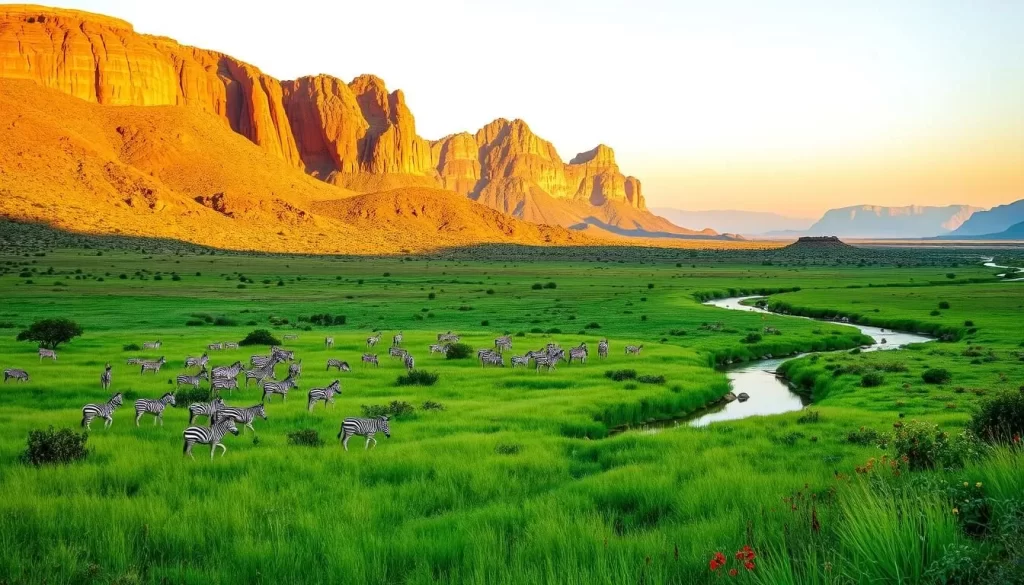
Navigating Afternoon Thunderstorms
Afternoon thunderstorms are characteristic of this season, typically arriving in short, intense bursts. While they can be dramatic, they rarely have a negative impact on travel plans, and the clear skies that follow offer excellent photography opportunities.
Benefits of Traveling During Low Season
Traveling during the green season has several benefits, including reduced rates, fewer tourists, and a more authentic experience. Despite the challenges in spotting wildlife due to the thicker vegetation and dispersed animals, the landscape photography opportunities are unparalleled.
| Aspect | Dry Season | Green Season |
|---|---|---|
| Landscape | Arid and dry | Lush and green |
| Wildlife Viewing | Easier due to concentrated animals around waterholes | More challenging due to dispersed animals and thicker vegetation |
| Photography | Stark desert scenes | Dramatic stormy skies and vibrant green backdrops |
| Tourist Season | Peak tourist season | Low season, fewer tourists |
Month-by-Month Weather Guide for Namibia
To make the most of your Namibian adventure, it’s vital to understand the country’s month-by-month weather guide. Namibia’s climate varies significantly across different regions and times of the year, impacting the best time for activities such as wildlife viewing and desert exploration.
January to March: Summer Heat and Occasional Rains
The summer months of January to March are characterized by high temperatures, often exceeding 90°F, with occasional afternoon rain showers. While the heat can be intense, the landscape remains lush following the rainy season, making it an attractive time for certain travelers.
- High temperatures and humidity
- Occasional rain showers
- Lush landscapes
April to June: Transition to the Dry Season
As the rainy season ends, April to June brings a transition to drier conditions, with May being particularly pleasant. Temperatures cool down, and the air is clear and fresh, making it an ideal time for outdoor activities.
- Cooling temperatures
- Clear skies
- Comfortable daytime conditions
July to September: Peak Dry Season
The peak dry season, from July to September, offers stable weather patterns with virtually no rain and clear skies. Daytime temperatures range from 68-79°F, but nights can be cold, especially in desert areas.
- Stable weather
- Clear skies
- Cold nights
October to December: Building Heat and Early Rains
As the dry season progresses, October to December sees rising temperatures and the potential for early rains. While conditions can be variable, this period is still favorable for wildlife viewing.
- Rising temperatures
- Potential for early rains
- Favorable for wildlife viewing
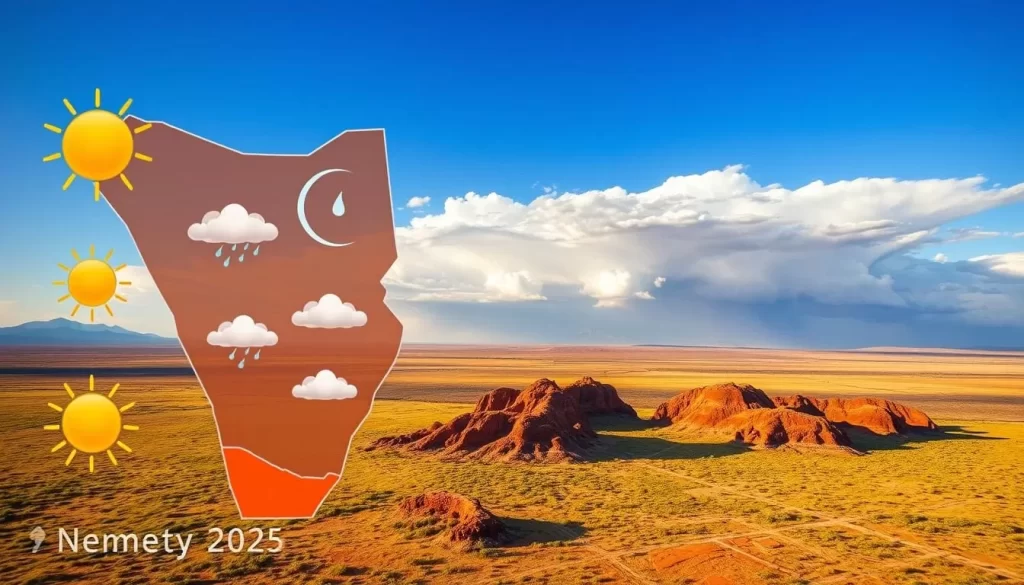
Understanding these monthly variations is essential for planning your trip to Namibia, ensuring that you’re prepared for the conditions and can make the most of your adventure.
Regional Weather Considerations for Your Namibia Trip
Namibia’s diverse regions experience significantly different climate patterns, making regional weather a key consideration for travelers. Understanding these variations is crucial for planning a comprehensive trip that might span multiple climate zones.
Coastal Areas: The Skeleton Coast and Swakopmund
The Skeleton Coast and Swakopmund along the Atlantic Ocean feature surprisingly cool temperatures year-round, with frequent fog and temperatures rarely exceeding 75°F. The coastal fog provides crucial water for desert-adapted plants and animals, creating a unique ecosystem.
Central Highlands: Windhoek and Surroundings
The Central Highlands around Windhoek experience more moderate temperatures than the extreme desert regions, with greater rainfall during the wet season. This region’s climate is relatively mild, making it a comfortable destination year-round.
Northern Namibia: Etosha and Caprivi Strip
Northern Namibia, including Etosha National Park, follows the typical dry/wet season pattern but with more pronounced temperature variations between seasons. The Caprivi Strip, known for its high rainfall, offers fantastic birdwatching opportunities during the summer months.
| Region | Climate Characteristics | Best Time to Visit |
|---|---|---|
| Skeleton Coast | Cool temperatures, frequent fog | Year-round |
| Central Highlands | Moderate temperatures, greater rainfall during wet season | Year-round |
| Northern Namibia (Etosha, Caprivi) | Dry/wet season pattern, pronounced temperature variations | Dry season for Etosha, summer for Caprivi |
Planning Your Weather-Perfect Namibian Adventure
To make the most of your trip to Namibia, it’s essential to consider the optimal time for your specific travel goals. The best time to visit Namibia is from July to October, when temperatures are mild and rainfall is scarce, making it ideal for wildlife viewing and safari experiences.
For first-time visitors, the period between July and September is particularly recommended due to the reliable weather conditions and exceptional opportunities to see animals at Etosha National Park. If you’re interested in photography, consider visiting during May-June for lush landscapes or August-September for stark desert contrasts.
Regardless of when you visit, be sure to pack layers for temperature extremes and consider the availability of water for both your needs and wildlife viewing expectations. By planning carefully, you can have a memorable Namibian adventure tailored to your preferences.
The above is subject to change.
Check back often to TRAVEL.COM for the latest travel tips and deals.
